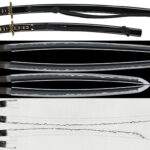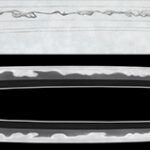Ordering number:AS24076
Kodachi: In Shirasaya (NBTHK Tokubetsu Hozon Token)
We divide 4 sections for each sword as Saijyo Saku, Jyojyo Saku, Jyo Saku, and Regular Saku.
This sword ranks as Saijyo Saku for works by Osumi Toshihira.
Habaki: Double-layered gold-plated.
Blade Length: 59.9 cm (23.58 in).
Curvature: 2.4 cm (0.94 in).
Mekugi Hole: 1.
Width at Base (Motohaba): 3.15 cm (1.24 in).
Width at Tip (Sakihaba): 2.34 cm (0.92 in).
Thickness (Kasane): 0.76 cm (0.30 in).
Sword Weight: 780 grams (27.51 oz).
Era: May, Showa 56 (1981).
Shape: Slightly wide and thick, with two grooves carved on both sides, deep curvature, and a regular kissaki.
Jigane: Mokume hada mixed with ko-itame hada, forming a refined jigane.
Hamon: Suguha style with prominent small ashi, and a straight boshi that rounds back in a small turn at the tip.
Features: Osumi Toshihira specialized in the suguha hamon style and produced this type consistently until his passing.
Creating a flawless suguha is exceedingly challenging, as even minor flaws can compromise the work.
This is considered a masterpiece in the Aoe-style replica.
Aoi Art’s Comment: Osumi Toshihira was born in Showa 7 (1932) in Ota City.
In Showa 27 (1952), he trained under Miyairi Shohei in Nagano Prefecture, who was later designated a Living National Treasure in Showa 38 (1963).
Toshihira then returned to Ota City, established his own workshop, and honed his skills, winning the highest Masamune Prize three times at the New Japanese Sword Competition.
In Heisei 9 (1997), he was also designated a Living National Treasure as a holder of Important Intangible Cultural Properties.
His lifelong dedication to perfecting the suguha style, which led to his designation as a Living National Treasure, is a testament to his extraordinary commitment.
Sadly, he passed away on October 4, Heisei 21 (2009) at the age of 77.
NBTHK Tokubetsu Hozon Token.
Aoi Art estimation paper.
Whole Oshigata.
Auction Starting Price:1,200,000JPY
Place Bid
Related Items:
 Dai Sho : Motohira(Dai Sho:NBTHK Tokubetsu Hozon Token)(Daisho Koshirae: NBTHK Tokubetsu Hozon Tosogu)
Dai Sho : Motohira(Dai Sho:NBTHK Tokubetsu Hozon Token)(Daisho Koshirae: NBTHK Tokubetsu Hozon Tosogu)
 Daisho: Morioka ju Yamaguchi Kiyofusa Saku Kore(Mukansa Swordsmith)
Daisho: Morioka ju Yamaguchi Kiyofusa Saku Kore(Mukansa Swordsmith)
 Daisho:Tame Minobe Akihide Shi Chikushu Sanno Ju Sotsutomu Saku Showa 60 Nen 8 Gatsu Kichijitsu (August 1985)(NBTHK Hozon Token)
Daisho:Tame Minobe Akihide Shi Chikushu Sanno Ju Sotsutomu Saku Showa 60 Nen 8 Gatsu Kichijitsu (August 1985)(NBTHK Hozon Token)
 Wakizashi: Omi Daijo Fujiwara Tadahiro(NBTHK Tokubetsu Hozon Token)
Wakizashi: Omi Daijo Fujiwara Tadahiro(NBTHK Tokubetsu Hozon Token)
 Wakizashi(long Tanto): Yamaguchi Kiyofusa, 1989
Wakizashi(long Tanto): Yamaguchi Kiyofusa, 1989
 Wakizashi:Ichi Dewa no Kami Yukihiro(NBTHK Tokubetsu Hozon Token)
Wakizashi:Ichi Dewa no Kami Yukihiro(NBTHK Tokubetsu Hozon Token)






